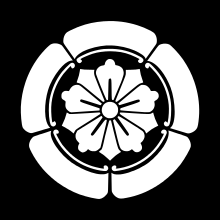Ōmura (clan)
The Ōmura ( Japanese 大村 氏 , Ōmura-shi ) were a family of the Japanese sword nobility ( Buke ) from the province of Hizen , which was derived from Fujiwara no Sumitomo († 941). With an income of 28,000 koku , the Ōmura residing in Ōmura ( Nagasaki prefecture ) belonged to the smaller Tozama daimyo of the Edo period .
genealogy
- Tadazumi ( 忠 澄 ), descendant of Sumitomo in the eighth generation, called himself Ōmura after the place in Hizen where he resided.
- Sumitada ( 純 忠 ; 1532–1587), son of Arima Haruzumi, was chosen to succeed Ōmura Sumiakis. He was baptized in 1562 and took the name Bartholomäus / Bartolomeo ( バ ル ト ロ メ オ , Barutoromeo ). He was the first Christian daimyo and remained true to the faith until his death. In 1568, the port of Fukae was opened to foreign traffic under the new name Nagasaki .
- Yoshiaki ( 喜 前 ; 1568–1615), Sumitada's son, was also a Christian, baptized in the name of Sanche. In the disputes in 1600 about the successor to Toyotomi Hideyoshis , he stood against Tokugawa Ieyasu and had to leave his domain to his son. He spent the rest of his life wasting time.
- Sumiyori ( 純 頼 ; 1592–1619), Yoshiaki's son, was, like his grandfather, baptized in the name of Bartholomew. Towards the end of his life, however, he became a persecutor of Christians. - The family continued to live in Ōmura with an income of 28,000 koku. The last daimyo was
- Sumihiro ( 純 熈 ; 1831-1882). From 1885 the head first held the title Vice Count, from 1891 the title Graf.
Individual evidence
- ↑ Furusawa, Tsunetoshi: Kamon daichō . Kin'ensha, undated, ISBN 4-321-31720-7 , pp.
- ↑ Excerpt from the map of the district "Soto-Sakurada" from approx. 1850.
literature
- Edmond Papinot: Historical and Geographical Dictionary of Japan. Reprint of the 1910 edition. Tuttle, 1972, ISBN 0-8048-0996-8 .
- Ikeda, Koichi: Omura-jo in: Miura, Masayuki (ed.): Shiro to jinya. Saikoku-hen. Gakken, 2006. ISBN 978-4-05-604379-2 .

